第二章 词法翻译一般技巧(1--7法)
- 格式:ppt
- 大小:404.00 KB
- 文档页数:37
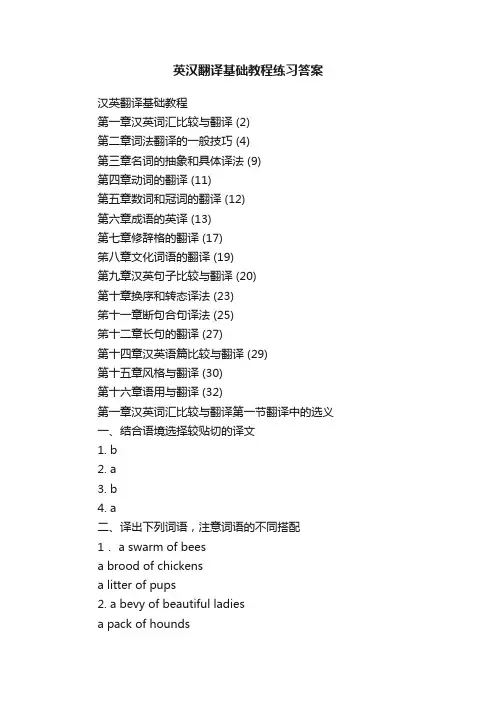
英汉翻译基础教程练习答案汉英翻译基础教程第一章汉英词汇比较与翻译 (2)第二章词法翻译的一般技巧 (4)第三章名词的抽象和具体译法 (9)第四章动词的翻译 (11)第五章数词和冠词的翻译 (12)第六章成语的英译 (13)第七章修辞格的翻译 (17)笫八章文化词语的翻译 (19)第九章汉英句子比较与翻译 (20)第十章换序和转态译法 (23)笫十一章断句合句译法 (25)笫十二章长句的翻译 (27)第十四章汉英语篇比较与翻译 (29)第十五章风格与翻译 (30)第十六章语用与翻译 (32)第一章汉英词汇比较与翻译第一节翻译中的选义一、结合语境选择较贴切的译文1. b2. a3. b4. a二、译出下列词语,注意词语的不同搭配1. a swarm of beesa brood of chickensa litter of pups2. a bevy of beautiful ladiesa pack of houndsa team of ducksa herd of antelopes3. unfailing supportproactive fiscal policymake effective use of overseas resources4. make a phone calltake a taxiknit a woolen sweaterfetch waterplay basketballspray insecticide5. basic wagecapital constructionessential commodityprimary industryfundamental interest三、翻译下列句子,注意画线词语的理解1. The two leaders exchanged views on bilateral relations and issues of common concern2. Party members should listen carefully to the opinions of the general public.3. They offered some suggestions for the revision of the plan.4. Everyone complained against such a practice.5. They had a dispute at the meeting.6. You should follow the doctor's advice.7. They reached a consensus on this issue.8. There is still some unfinished business to settle.9. We have consulted him about the matter.10. Please go back. There is nothing of your concern now第二节翻译中的选词一、翻译下列各句,注意词的选择和搭配。
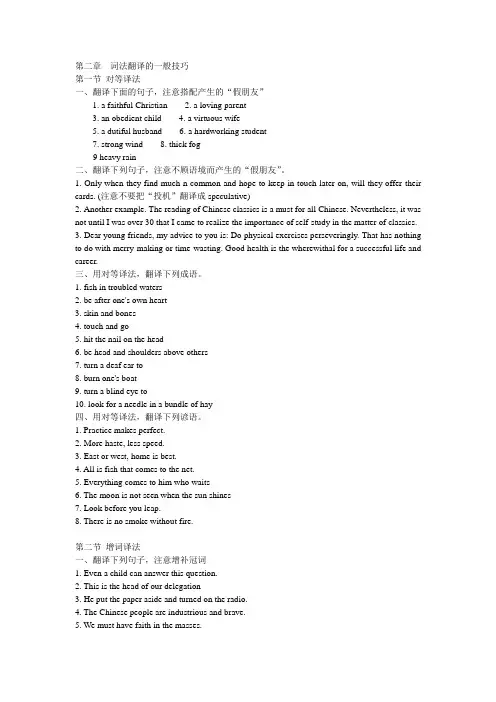
第二章词法翻译的一般技巧第一节对等译法一、翻译下面的句子,注意搭配产生的“假朋友”1. a faithful Christian2. a loving parent3. an obedient child4. a virtuous wife5. a dutiful husband6. a hardworking student7. strong wind 8. thick fog9 heavy rain二、翻译下列句子,注意不顾语境而产生的“假朋友”。
1. Only when they find much n common and hope to keep in touch later on, will they offer their cards. (注意不要把“投机”翻译成speculative)2. Another example. The reading of Chinese classics is a must for all Chinese. Nevertheless, it was not until I was over 30 that I came to realize the importance of self-study in the matter of classics.3. Dear young friends, my advice to you is: Do physical exercises perseveringly. That has nothing to do with merry-making or time-wasting. Good health is the wherewithal for a successful life and career.三、用对等译法,翻译下列成语。
1. fish in troubled waters2. be after one's own heart3. skin and bones4. touch and go5. hit the nail on the head6. be head and shoulders above others7. turn a deaf ear to8. burn one's boat9. turn a blind eye to10. look for a needle in a bundle of hay四、用对等译法,翻译下列谚语。
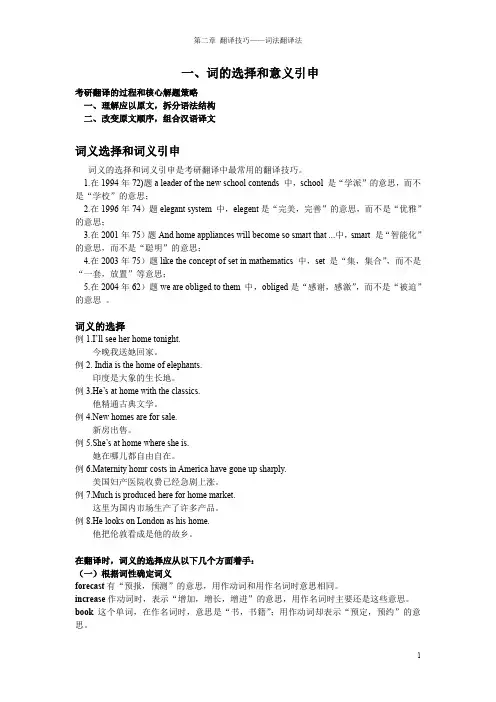
一、词的选择和意义引申考研翻译的过程和核心解题策略一、理解应以原文,拆分语法结构二、改变原文顺序,组合汉语译文词义选择和词义引申词义的选择和词义引申是考研翻译中最常用的翻译技巧。
1.在1994年72)题a leader of the new school contends 中,school 是“学派”的意思,而不是“学校”的意思;2.在1996年74)题elegant system 中,elegent是“完美,完善”的意思,而不是“优雅”的意思;3.在2001年75)题And home appliances will become so smart that ...中,smart 是“智能化”的意思,而不是“聪明”的意思;4.在2003年75)题like the concept of set in mathematics 中,set 是“集,集合”,而不是“一套,放置”等意思;5.在2004年62)题we are obliged to them 中,obliged是“感谢,感激”,而不是“被迫”的意思。
词义的选择例1.I’ll see her home tonight.今晚我送她回家。
例2. India is the home of elephants.印度是大象的生长地。
例3.He’s at home with the classics.他精通古典文学。
例4.New homes are for sale.新房出售。
例5.She’s at home where she is.她在哪儿都自由自在。
例6.Maternity homr costs in America have gone up sharply.美国妇产医院收费已经急剧上涨。
例7.Much is produced here for home market.这里为国内市场生产了许多产品。
例8.He looks on London as his home.他把伦敦看成是他的故乡。


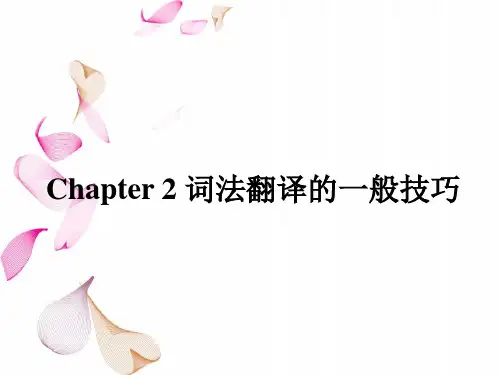
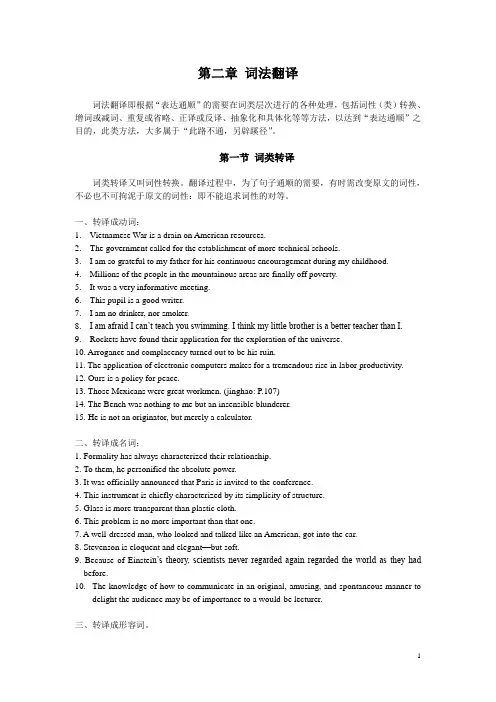
第二章词法翻译词法翻译即根据“表达通顺”的需要在词类层次进行的各种处理,包括词性(类)转换、增词或减词、重复或省略、正译或反译、抽象化和具体化等等方法,以达到“表达通顺”之目的,此类方法,大多属于“此路不通,另辟蹊径”。
第一节词类转译词类转译又叫词性转换。
翻译过程中,为了句子通顺的需要,有时需改变原文的词性,不必也不可拘泥于原文的词性:即不能追求词性的对等。
一、转译成动词:1.Vietnamese War is a drain on American resources.2.The government called for the establishment of more technical schools.3.I am so grateful to my father for his continuous encouragement during my childhood.lions of the people in the mountainous areas are finally off poverty.5.It was a very informative meeting.6.This pupil is a good writer.7.I am no drinker, nor smoker.8.I am afraid I can’t teach you swimming. I think my little brother is a better teacher than I.9.Rockets have found their application for the exploration of the universe.10. Arrogance and complacency turned out to be his ruin.11. The application of electronic computers makes for a tremendous rise in labor productivity.12. Ours is a policy for peace.13. Those Mexicans were great workmen. (jinghao: P.107)14. The Bench was nothing to me but an insensible blunderer.15. He is not an originator, but merely a calculator.二、转译成名词:1. Formality has always characterized their relationship.2. To them, he personified the absolute power.3. It was officially announced that Paris is invited to the conference.4. This instrument is chiefly characterized by its simplicity of structure.5. Glass is more transparent than plastic cloth.6. This problem is no more important than that one.7. A well-dressed man, who looked and talked like an American, got into the car.8. Stevenson is eloquent and elegant—but soft.9. Because of Einstei n’s theory, scientists never regarded again regarded the world as they had before.10. The knowledge of how to communicate in an original, amusing, and spontaneous manner todelight the audience may be of importance to a would-be lecturer.三、转译成形容词。
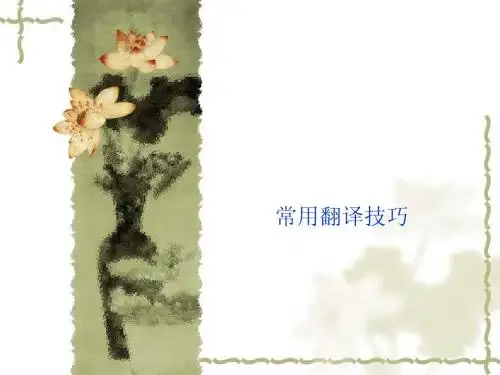
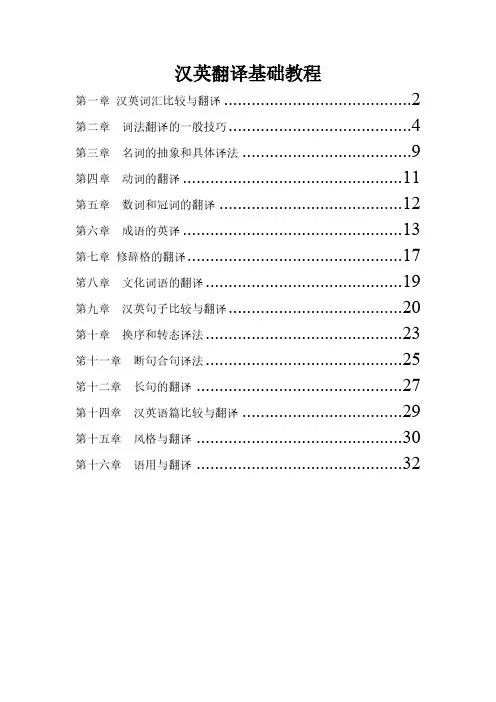
汉英翻译基础教程第一章汉英词汇比较与翻译 (2)第二章词法翻译的一般技巧 (4)第三章名词的抽象和具体译法 (9)第四章动词的翻译 (11)第五章数词和冠词的翻译 (12)第六章成语的英译 (13)第七章修辞格的翻译 (17)笫八章文化词语的翻译 (19)第九章汉英句子比较与翻译 (20)第十章换序和转态译法 (23)笫十一章断句合句译法 (25)笫十二章长句的翻译 (27)第十四章汉英语篇比较与翻译 (29)第十五章风格与翻译 (30)第十六章语用与翻译 (32)第一章汉英词汇比较与翻译第一节翻译中的选义一、结合语境选择较贴切的译文1. b2. a3. b4. a二、译出下列词语,注意词语的不同搭配1. a swarm of beesa brood of chickensa litter of pups2. a bevy of beautiful ladiesa pack of houndsa team of ducksa herd of antelopes3. unfailing supportproactive fiscal policymake effective use of overseas resources4. make a phone calltake a taxiknit a woolen sweaterfetch waterplay basketballspray insecticide5. basic wagecapital constructionessential commodityprimary industryfundamental interest三、翻译下列句子,注意画线词语的理解1. The two leaders exchanged views on bilateral relations and issues of common concern2. Party members should listen carefully to the opinions of the general public.3. They offered some suggestions for the revision of the plan.4. Everyone complained against such a practice.5. They had a dispute at the meeting.6. You should follow the doctor's advice.7. They reached a consensus on this issue.8. There is still some unfinished business to settle.9. We have consulted him about the matter.10. Please go back. There is nothing of your concern now第二节翻译中的选词一、翻译下列各句,注意词的选择和搭配。
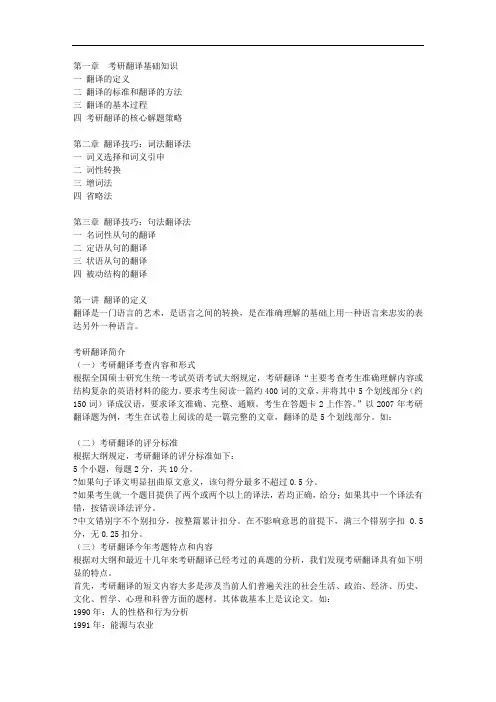
第一章考研翻译基础知识一翻译的定义二翻译的标准和翻译的方法三翻译的基本过程四考研翻译的核心解题策略第二章翻译技巧:词法翻译法一词义选择和词义引申二词性转换三增词法四省略法第三章翻译技巧:句法翻译法一名词性从句的翻译二定语从句的翻译三状语从句的翻译四被动结构的翻译第一讲翻译的定义翻译是一门语言的艺术,是语言之间的转换,是在准确理解的基础上用一种语言来忠实的表达另外一种语言。
考研翻译简介(一)考研翻译考查内容和形式根据全国硕士研究生统一考试英语考试大纲规定,考研翻译“主要考查考生准确理解内容或结构复杂的英语材料的能力。
要求考生阅读一篇约400词的文章,并将其中5个划线部分(约150词)译成汉语,要求译文准确、完整、通顺。
考生在答题卡2上作答。
”以2007年考研翻译题为例,考生在试卷上阅读的是一篇完整的文章,翻译的是5个划线部分。
如:(二)考研翻译的评分标准根据大纲规定,考研翻译的评分标准如下:5个小题,每题2分,共10分。
如果句子译文明显扭曲原文意义,该句得分最多不超过0.5分。
如果考生就一个题目提供了两个或两个以上的译法,若均正确,给分;如果其中一个译法有错,按错误译法评分。
中文错别字不个别扣分,按整篇累计扣分。
在不影响意思的前提下,满三个错别字扣0.5分,无0.25扣分。
(三)考研翻译今年考题特点和内容根据对大纲和最近十几年来考研翻译已经考过的真题的分析,我们发现考研翻译具有如下明显的特点。
首先,考研翻译的短文内容大多是涉及当前人们普遍关注的社会生活、政治、经济、历史、文化、哲学、心理和科普方面的题材。
其体裁基本上是议论文。
如:1990年:人的性格和行为分析1991年:能源与农业1992年:智力评估的科学性1993年:科学研究的方法1994年:科学家、技术与科学发展的关系1995年:标准化测试与评估1996年:科学发展的差别和动力1997年:动物的权利1998年:天体物理学中的大爆炸理论1999年:历史研究的方法论2000年:政府调控与工业化发展2001年:计算机与未来生活2002年:行为科学的发展2003年:人类学的发展2004年:语言学2005年:传媒领域中的电视媒介2006年:美国知识分子的作用2007年:法学在新闻报道中的作用。

第一节:词义的选择For example: Last1) He is the last man to come.他是最后来的。
2) I wouldn’t marry you even if you were the last person on earth.即使世上只剩下你一个人,我也不会和你结婚的。
3) He is the last man to do such kind of dirty thing.他决不会做这种肮脏的事。
4) He is the last person for such a job.他最不配/不适合干这活。
For example: story•This war is becoming the most important story of this generation.这场战争行将成为这一代人的最重大的事件。
•It is quite another story now.现在的情况完全不同了。
•Some reporters who were not included in the session broke the story.有些没让参加那次会议的记者把内情捅出去了。
•He'll be very happy if that story holds up.如果这一说法当真,那他就太高兴了。
•story•The Rita Haywoth’s story is one of the saddest.丽泰·海华丝的遭遇算最惨的了。
• A young man came to Scotti‘s office with a story.一个年轻人来到斯科特的办公室报案。
1•Last Dec. the Post first reported that probes were being made in each of those cities, but officials refused to confirm the story.去年12月,《邮报》首先报道侦察工作已在那些城市里进行,但官员们拒绝证实这条消息。
❝翻译方法和技巧(六)❝英汉互译中的增词法和减词法❝根据上下文的意思,逻辑关系,句法特点和表达习惯增加原文中没有出现但是实际包含的词,或者减少原文中虽出现但译文表达用不着的词。
❝翻译的增词法和减词法是一个事物的互为补充的两个方面,如果汉译英要加词,那么英译汉就要减词。
❝一、增词法-增词不增意❝增词法:這種方式多半用在漢译英里。
漢語無主句較多,而英語句子一般都要有语法主語,所以在翻譯汉語无主句的時候,除了少數可用英語无主句、被動語态或”There be…”結构來翻譯以外,一般都要根语語境補出主語,使句子完整。
❝英漢兩種語言在名詞、代詞、連詞、介詞和冠詞的使用方法上也存在很大差別。
例如,英語中代詞使用頻率較高,凡說到人的器官和歸某人所有的或與某人有关的事物時,必須在前面加上物主代詞。
因此,在漢譯英時需要增補物主代詞,而在英譯漢時又需要根據情況這當地刪減。
❝英語詞与詞、詞組与詞組以及句子与句子的逻辑关系一般用連詞來表示,而漢語則往往通過上下文和語序來表示這種关系。
因此,在漢譯英時常常需要增補連詞。
❝你来我就走❝I will leave if/as you come.❝ 1.英汉互译中最常见的增减词就是范畴词(方面、方式、问题、程度、情况之类的词)❝在下个世纪,很多国家将出现技术匮乏现象。
❝There will be a skill shortage in many countries in the next century.❝许多人主张采取强有力的措施镇压走私活动❝Many advocated strong action to crack down the smuggling.❝ 2.原文中一些不言而明需要根据上下文的情况和用法加上去。
❝You were, you are, and you remain to be the consumers of our products.❝你们永远是我的客户。
❝你们过去是,现在是,将来仍然是我们的客户。
第一章翻译标准与英汉对比请翻译下列句子。
1.Can you answer a question which I want to ask and which is puzzling me?2.Some books are to be tasted, others to be swallowed, and some few to be chewedand digested.3.That government of the people, by the people, and for the people, shall not perishfrom the earth.4.学得有趣,效率就会高;学得辛苦,效率就低。
5.请旅客在此填写报关表格。
6.认识错误,才能改正错误。
7.西部地域辽阔,交通不发达,首先要进行基础设施的建设。
作业答案:1.我有个问题不懂,想请教你,你能回答吗?(形合转为意合;化整为零)2.书有可浅尝者,有可吞食者,少数则需咀嚼消化。
(被动译成具有主动形式的简化被动态)3.这个民有、民治、民享的政府永世长存。
(化静为动)4.Learning is more efficient when it is fun, less efficient when it is drudgery. (意合转为形合;化零为整)5.Passengers are requested to fill in the customs declaration form here. (为使语气更委婉,主动变被动)6.Mistakes must be perceived before they can be corrected. (为加强上下文的连贯性,主动变被动)7.Since the western region covers a vast area with poor transportfacilities/transportation, we should first of all conduct infrastructure construction.(意合转为形合;化零为整)请将下列句子翻译成英文。